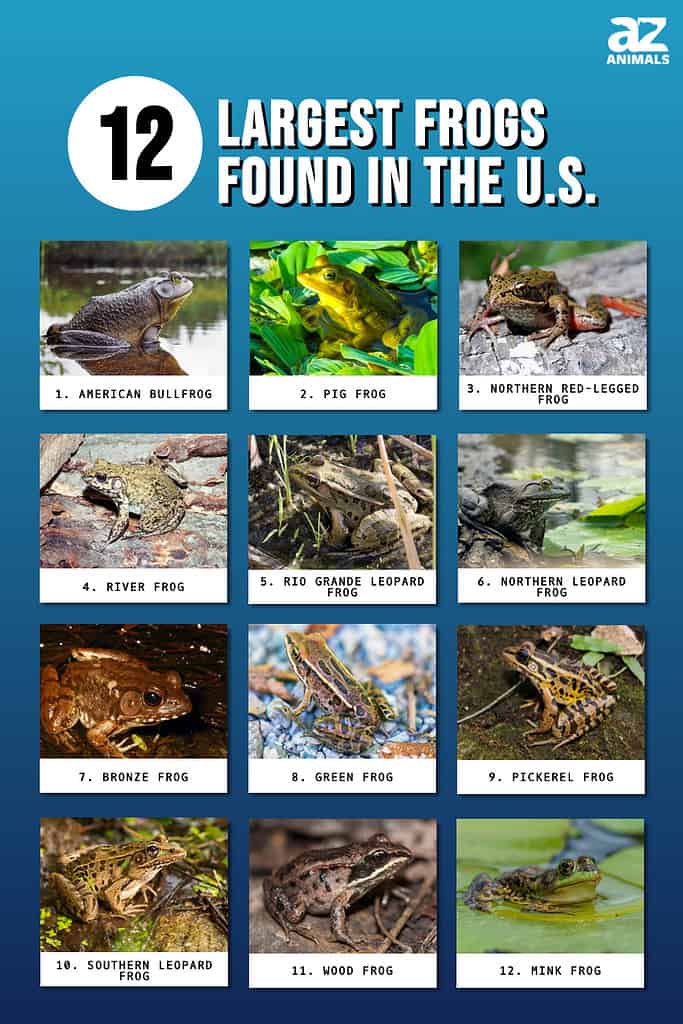
Frogs are fascinating creatures, and some of the largest ones found in the United States are truly impressive in size! From their loud croaks to their remarkable physical characteristics, these amphibians are a wonder to behold. If you’ve ever wondered about the largest frogs in U.S. bodies of water, you’re in for a treat. These creatures are not only magnificent but also have unique adaptations that help them thrive in their aquatic environments. Let’s discover the 12 largest frogs found in U.S. rivers, lakes, and ponds.
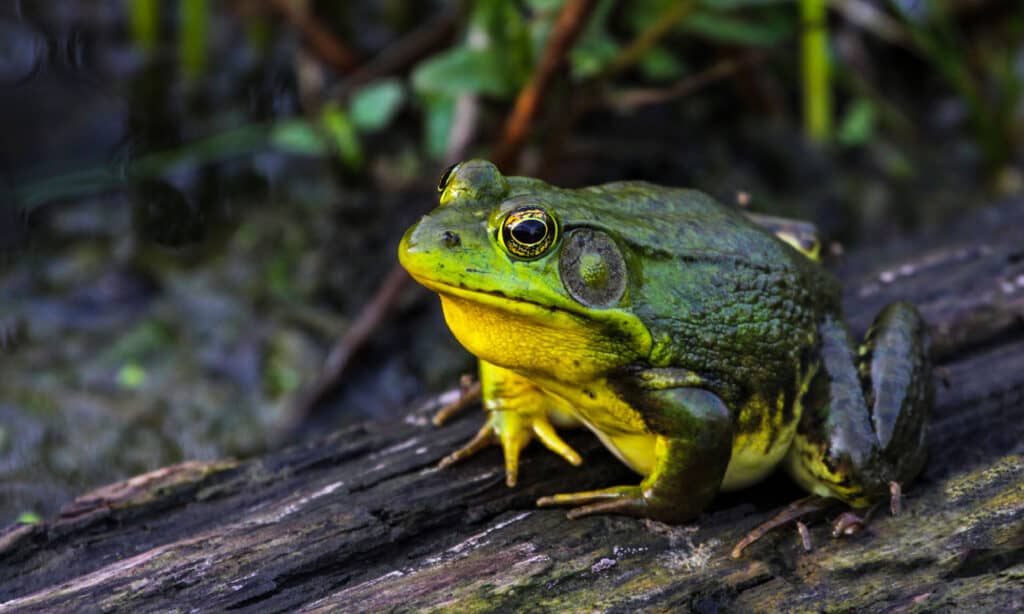
Frogs are fascinating creatures, and some of the largest ones found in the United States are truly impressive in size! Pictured: The American Bullfrog (
Lithobates catesbeianus).
©iStock.com/187715314
What is a Frog?
The genus Lithobates is a diverse group of American water frogs that includes 53 different species. These frogs are found throughout North and Central America, from Canada to Panama. The name Lithobates means rock-dweller, which reflects the fact that many of these frogs are found in or near rocky habitats, such as streams, rivers, and ponds.
Lithobates frogs vary widely in size and appearance, ranging from small and brightly colored to larger and more muted. Most species have smooth skin, although some have warts or bumps on their skin. Some species also have distinct markings, such as stripes or spots, on their backs and legs.
Unfortunately, many species of American water frogs are currently facing threats including habitat loss, pollution, climate change, and disease.
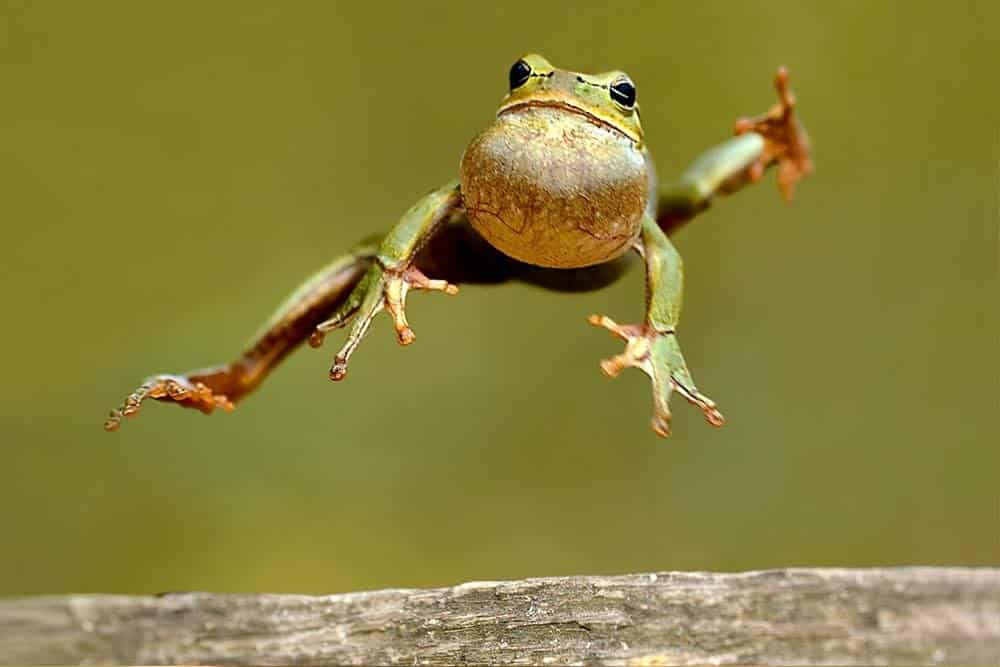
frogs vary widely in size and appearance, ranging from small and brightly colored to larger and more muted.
©kyslynskahal/Shutterstock.com
Discover the 12 Largest Frogs Found in U.S. Rivers, Lakes, and Ponds
1. The American Bullfrog
The largest frog found in bodies of water in the United States is the American Bullfrog (Lithobates catesbeianus). These frogs can grow up to eight inches (20 cm) in length and weigh up to 1.5 pounds (0.68 kg). They are found throughout the United States in freshwater habitats such as ponds, lakes, and rivers. In addition to their large size, they are also known for their distinctive jug-o-rum call, which is often heard during the warmer months of the year.
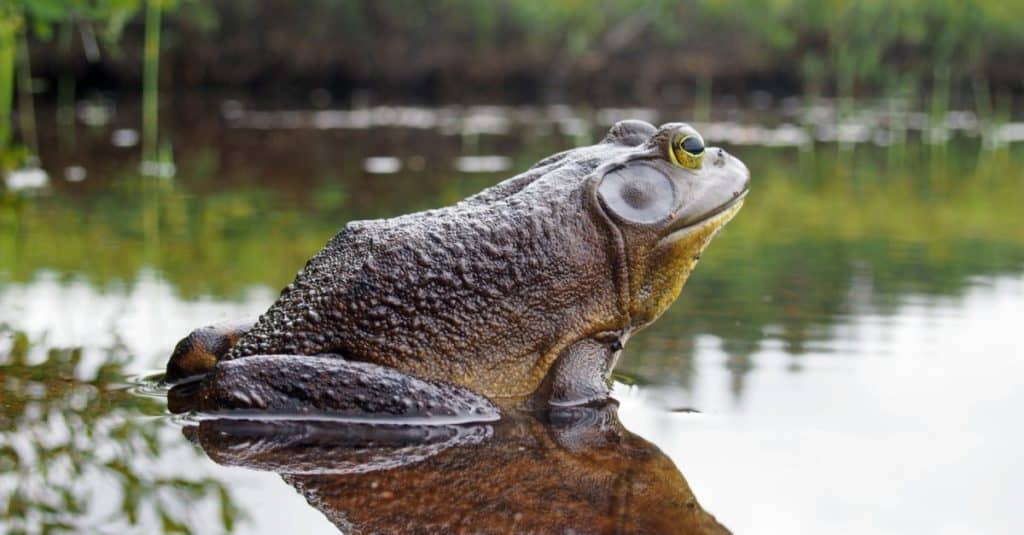
The largest frog found in bodies of water in the United States is the American Bullfrog (
Lithobates catesbeianus).
©Christian Ouellet/Shutterstock.com
2. Pig Frog
Lithobates grylio, commonly known as the pig frog, is a large aquatic frog species found in the Southeastern United States. Adult pig frogs can reach lengths of up to 8 inches (20 cm) and weigh over one pound (0.45 kg). Females tend to be larger than males. They have a flattened head and a broad, muscular body with strong hind legs that are adapted for swimming. Their skin is brown or gray with dark spots or blotches. They have a white belly.
Pig frogs are found in a variety of aquatic habitats such as swamps, marshes, and slow-moving streams and rivers. They are generally active at night and feed on a variety of prey including insects, crustaceans, and small fish. They are also known for their deep, grunting call that sounds like the vocalization of a pig, which is how they got their common name.
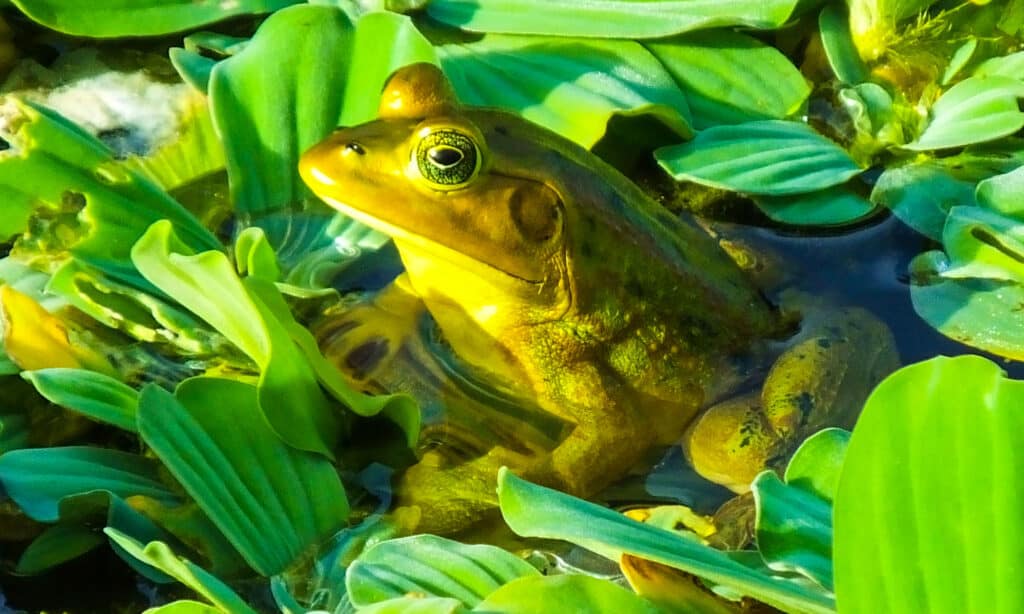
Adult pig frogs can reach lengths of up to 8 inches (20 cm) and weigh over 1 pound (0.45 kg).
©iStock.com/passion4nature
Both the American bullfrog and the pig frog can reach similar sizes, with adult individuals of both species growing up to 8 inches (20 cm) in length and weighing over one pound (0.45 kg). However, there are some physical differences between the two species, such as the shape of their heads and the pattern of their skin markings. They also have different ranges, with the American bullfrog being found throughout most of North America, while the pig frog is more restricted to the Southeastern United States.
3. Northern Red-legged Frog
The Northern red-legged frog (Rana aurora) is a medium-sized amphibian found in the Pacific Northwest. Adults can reach a length of 3 to 5 inches (7.5 to 13 cm), with females generally being larger than males. They have a distinctive reddish coloring on their legs and belly, which is where they get their common name. Their backs can vary in color from brown to green or gray, and they have dark spots or stripes that provide camouflage in their forested habitats.
Northern red-legged frogs are found in a variety of aquatic and terrestrial habitats, including forests, meadows, wetlands, and streams. The genus Rana contains pond frogs. They are most commonly found in or near bodies of water, such as ponds or slow-moving streams, where they breed and lay their eggs. Their breeding behavior involves males making a variety of vocalizations to attract females to their breeding sites.
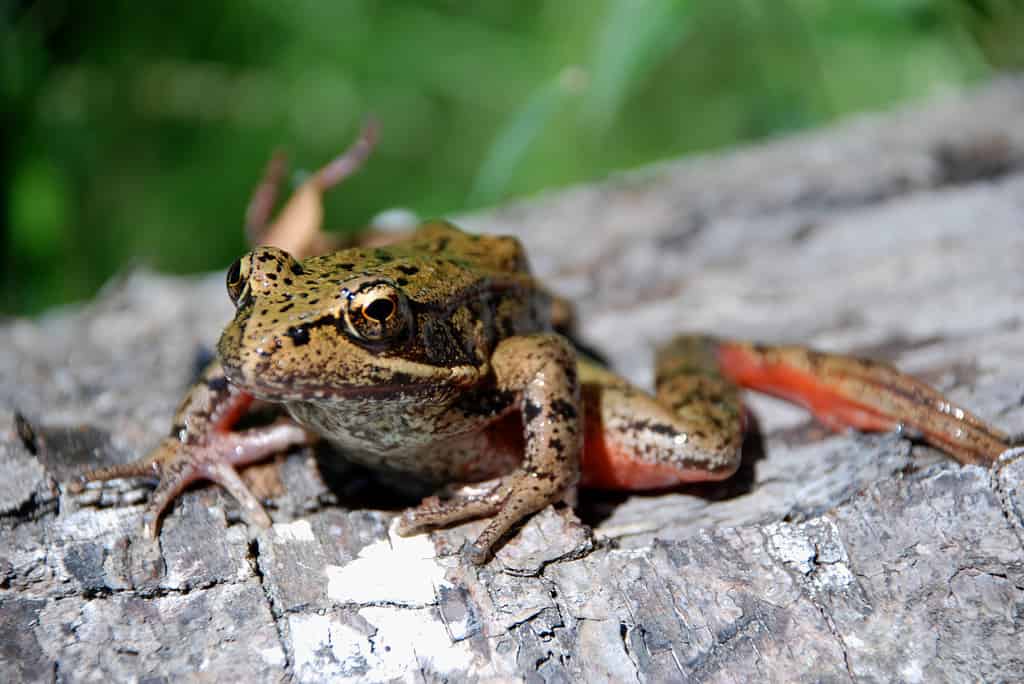
Adult Northern red-legged frogs can reach a length of 3 to 5 inches (7.5 to 13 cm)
©Amy Devine/Shutterstock.com
4. River Frog
Lithobates heckscheri, commonly known as the river frog, is a species of frog found in the Southeastern United States. Adult river frogs are medium-sized, measuring 1.5 to 5 inches (3.8 to 12.7 cm) in length. Females are generally larger than males. They have a flattened body shape, which helps them move through the water more efficiently, and they have long, muscular legs that are adapted for swimming and jumping. They are light brown or gray with darker spots or blotches on their backs. Their belly is white or yellowish in color.
As their name suggests, river frogs are found in or near bodies of water such as streams, rivers, and swamps. They are most common in slow-moving or still water with vegetation and a soft substrate. They are also known to inhabit nearby terrestrial habitats like forests, wetlands, and fields.
River frogs are active at night and feed on a variety of small prey such as insects, spiders, and small crustaceans. View a photo of a river frog here.
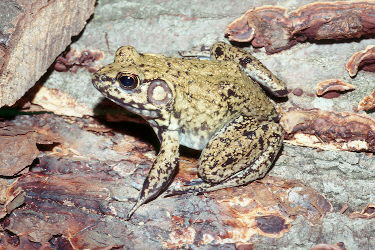
River Frogs are found in or near bodies of water such as streams, rivers, and swamps.
©Unknown author/Public Domain – License
5. Rio Grande Leopard Frog
The Rio Grande leopard frog (Lithobates berlandieri) is a species of frog found in the southwestern United States and northeastern Mexico. They are medium-sized frogs, measuring between two to five inches (5 to 13 cm) in length. They have a pattern of green or brown spots on their backs, with a white or cream-colored belly. Their skin can be rough or bumpy.
Rio Grande leopard frogs are semi-aquatic and are found in and around bodies of water such as streams, rivers, ponds, and wetlands. They are active at night and feed on a variety of small prey such as insects, spiders, and small fish. During the breeding season, males will call to attract females to their breeding sites, and the females will lay their eggs in the water.
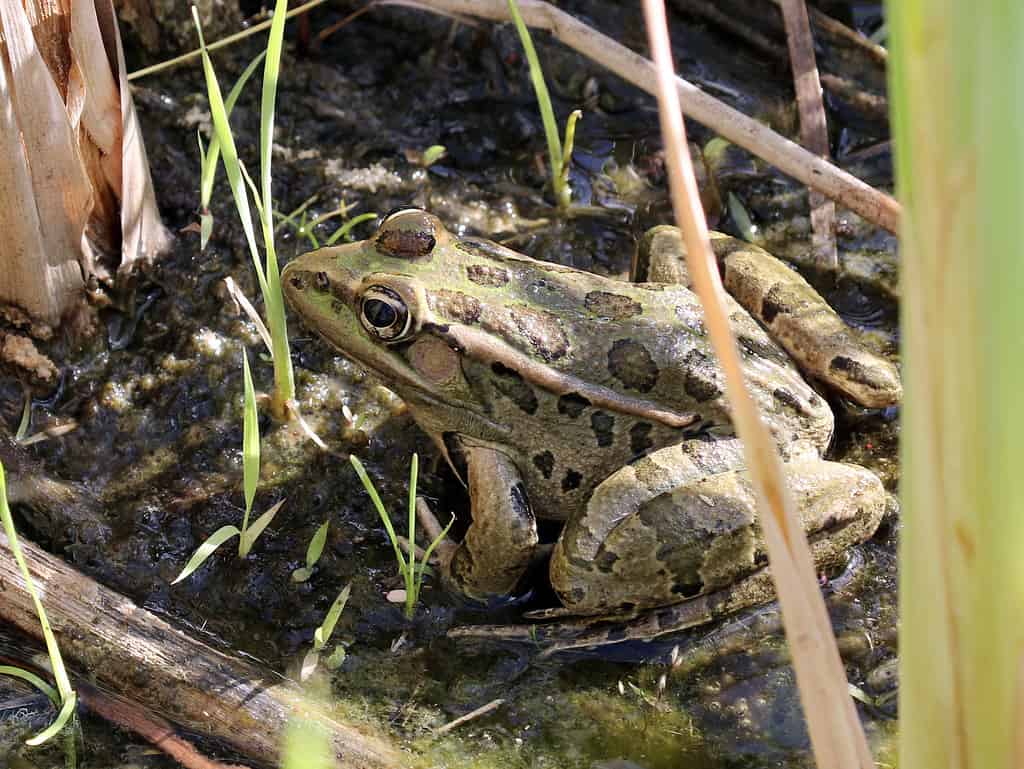
The Rio Grande Leopard Frog is active at night and feeds on a variety of small prey.
©Randy Bjorklund/Shutterstock.com
6. Northern Leopard Frog
The Northern leopard frog (Lithobates pipiens) is a medium-sized frog, with adults measuring between two to four inches (5 to 10 cm) long, making it one of the largest frogs found in the U.S. Their bodies are dark green or brown in color, with a distinctive pattern of dark spots on their backs. These spots are often surrounded by a light-colored ring or halo, which gives the frog its characteristic leopard-like appearance.
The Northern leopard frog is found across much of Canada and the United States and is one of the most widely distributed frog species in North America. They are found in a variety of habitats, including wetlands, marshes, and meadows, and are often associated with bodies of water such as ponds, lakes, and streams. They are also found in agricultural and suburban areas.
Northern leopard frogs are active during the day and are known for their long jumps and powerful legs. They feed on a variety of small prey such as insects, spiders, and worms. During the breeding season, males will call to attract females to their breeding sites, and the females will lay their eggs in the water. The tadpoles hatch from the eggs and undergo a metamorphosis into adult frogs.
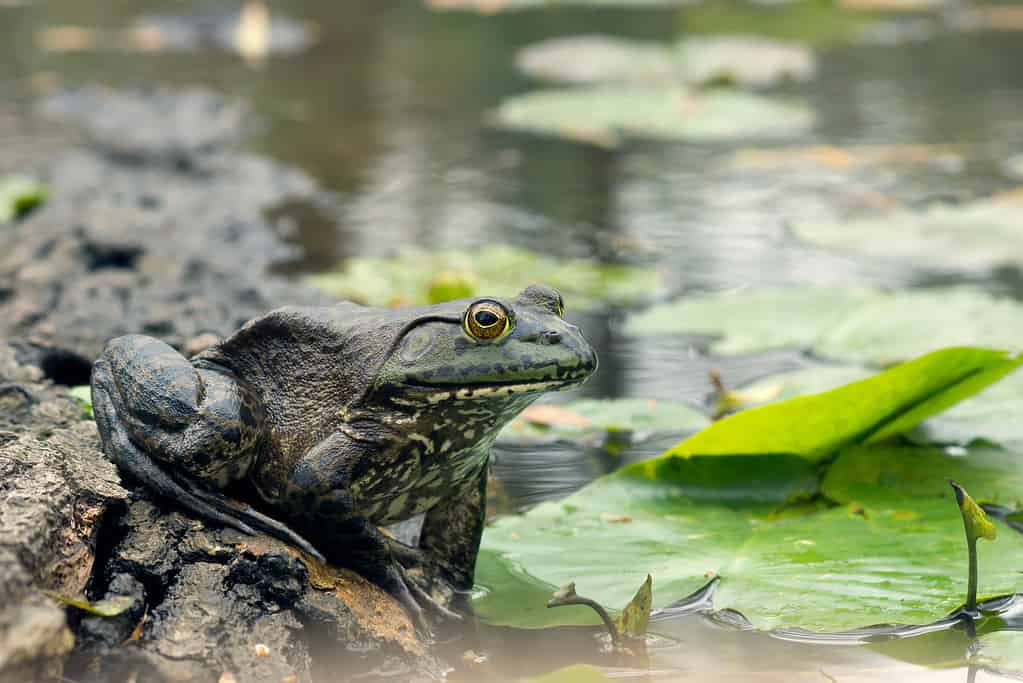
The Northern leopard frog is found across much of Canada and the United States and is one of the most widely distributed frog species in North America.
©IrinaK/Shutterstock.com
7. Bronze Frog / 8. Green Frog
The green frog (Lithobates clamitans) and the bronze frog (Lithobates clamitans clamitans) have a similar appearance and share many characteristics. Both species are greenish-brown or bronze in color, with smooth skin and dark spots on their back and sides. They measure two to four inches (5-10 cm). They are both found in similar habitats, such as ponds, lakes, and slow-moving streams. Both species are also known for their distinctive call, which is used by males to attract females during the breeding season.
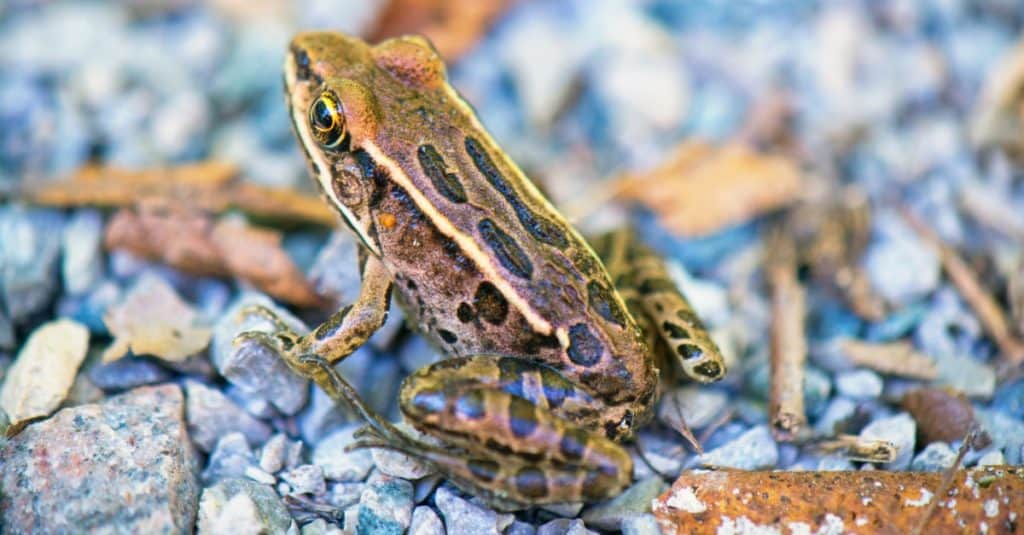
The green frog
(Lithobates clamitans) is widely distributed.
©iStock.com/rgbspace
The main difference between the two species is their geographic distribution. The green frog is found throughout much of Eastern North America, from Southern Canada to the Gulf of Mexico. The bronze frog has a more restricted distribution than the green frog. It is found in the Northern part of the green frog’s range, including the Great Lakes region and parts of Canada. Some scientists suggest that the green frog and bronze frog may have subtle differences in their physical characteristics and vocalizations, but these differences are not always easy to distinguish.
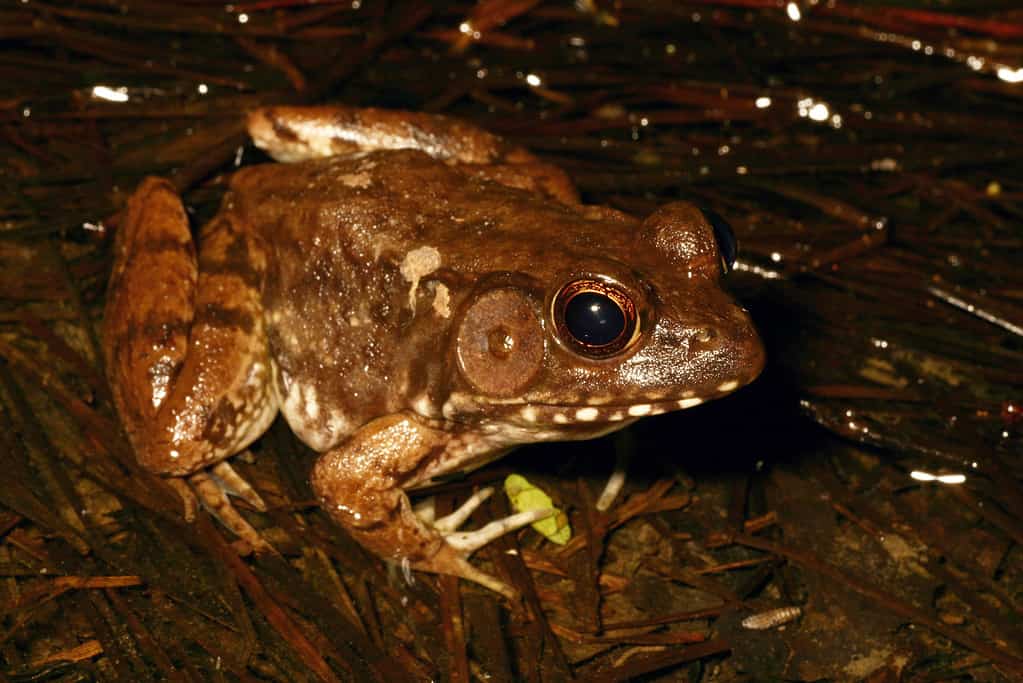
The bronze frog has a more restricted distribution than the green frog.
©Michael Benard/Shutterstock.com
9. Pickerel Frog
The pickerel frog (Lithobates palustris) is one of the largest frogs found in the U.S. It is a species of frog native to Eastern North America, ranging from the Great Lakes region to the Gulf of Mexico. It is a medium-sized frog, with adults ranging from 2.5 to 4 inches (6.4 – 10.2 cm) long. The pickerel frog is dark brown or black square blotches on its back and legs, and a bright yellow or orange underside. Its skin is rough and bumpy, and it has a pointed snout.
It is often mistaken for the similar-looking leopard frog, but the pickerel frog has smaller, more square-shaped spots and lacks the leopard frog’s distinct spots on its legs. Pickerel frogs are found in or near shallow, slow-moving bodies of water such as ponds, swamps, and streams. They prefer habitats with clean, clear water and plenty of vegetation. They are most active during the day and feed on a variety of insects and other small invertebrates.
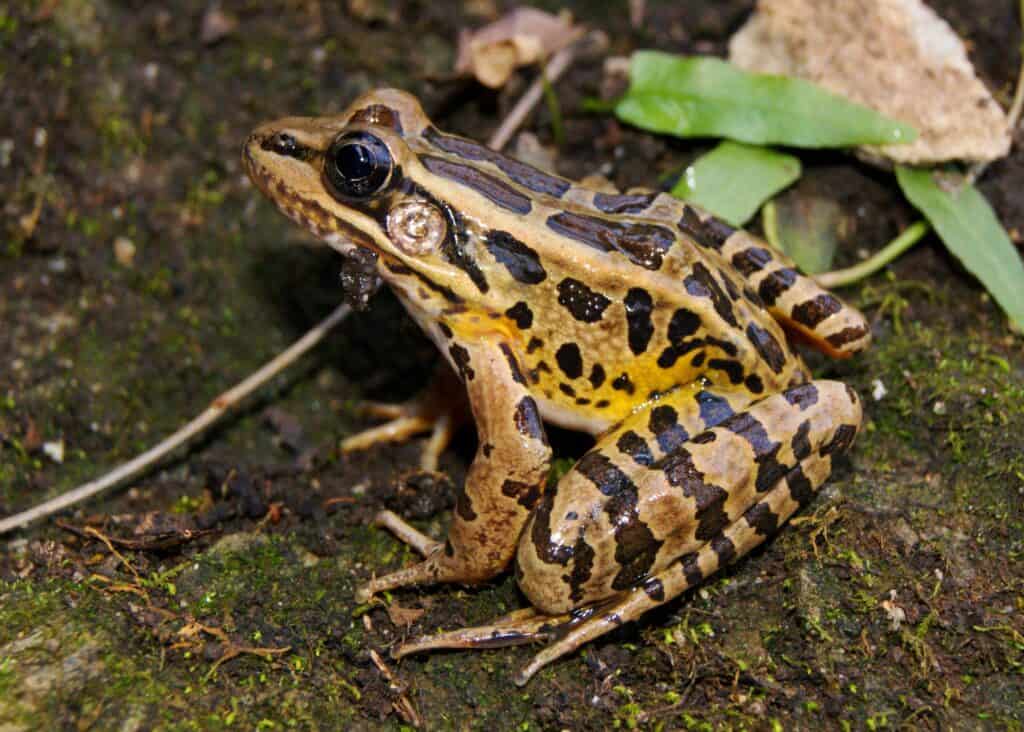
Pickerel Frogs are most active during the day and feed on a variety of insects and other small invertebrates.
©Matt Jeppson/Shutterstock.com
10. Southern Leopard Frog
The Southern leopard frog (Lithobates sphenocephalus) is a species of frog native to the Southeastern United States, ranging from Virginia to Florida and west to Texas. It is a medium-sized frog, with adults measuring 2 to 3.5 inches (5.1 to 8.9 cm) long, making it one of the largest frogs found in the U.S.
The Southern leopard frog has a green or brownish-green back covered with circular spots that are usually darker than the background color. Its legs are also spotted, and its belly is white with dark markings. It has a pointed snout and a ridge running from each eye down its back. There are several subspecies of Southern leopard frogs, each with slightly different coloration and markings.
Southern leopard frogs are found in or near shallow, slow-moving bodies of water such as ponds, swamps, and streams. They prefer habitats with plenty of vegetation and are most active at night. They feed on a variety of insects and other small invertebrates.
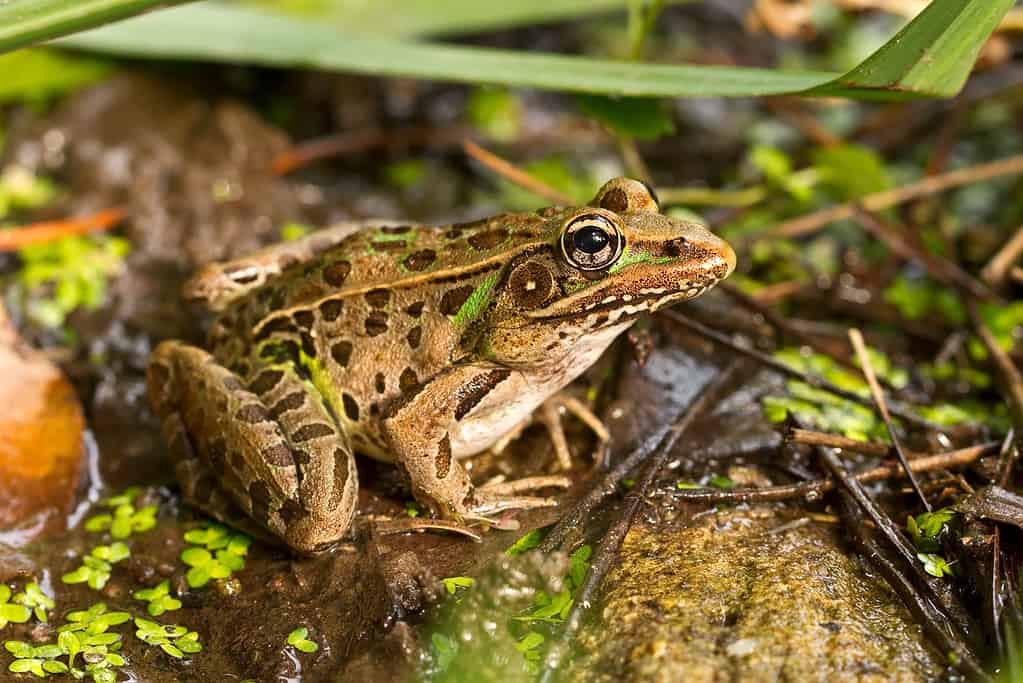
The Southern leopard frog has a green or brownish-green back covered with circular spots.
©LorraineHudgins/Shutterstock.com
11. Wood Frog
Lithobates sylvaticus, also known as the wood frog, is one of the largest frogs found in the U.S. It is a species of frog native to North America. It has a wide distribution, ranging from the Arctic Circle in Alaska and Canada to the Southern United States.
The wood frog is a small to medium-sized frog, with adults measuring two to three inches (5 to 7.6 cm) long.
They are brown or reddish-brown and are often marked with a dark mask around the eyes. The underside is light-colored and has a white or yellowish stripe running along each side of its body. One of the most interesting features of the wood frog is its ability to change color, becoming lighter or darker depending on the temperature and light levels in its environment. Wood frogs are also able to endure sub-freezing temperatures thanks to cryoprotectants that protect their tissues and organs from the damage caused by freezing temperatures.
Wood frogs are found in or near moist, wooded areas such as forests, swamps, and bogs. They breed in temporary pools or wetlands, and their tadpoles develop quickly, often transforming into adult frogs within just a few months.
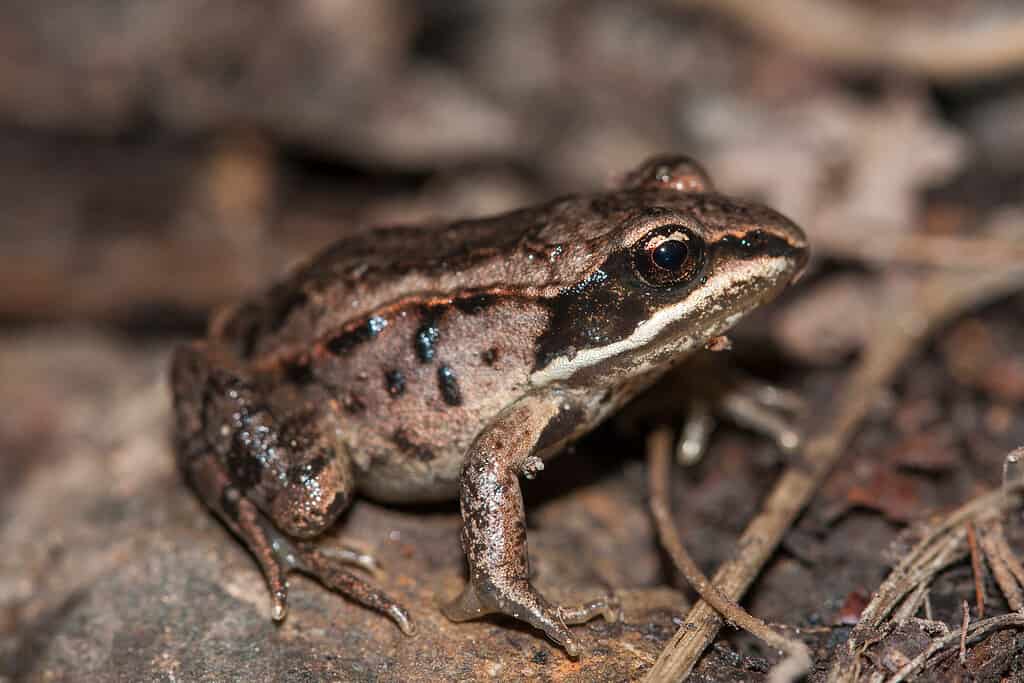
Wood frogs are also able to endure sub-freezing temperatures thanks to
cryoprotectants
that protect their tissues and organs from the damage caused by freezing temperatures.
©Viktor Loki/Shutterstock.com
12. Mink Frog
Last on the list of the largest frogs found in the U.S. is the mink frog. The mink frog (Lithobates septentrionalis), is a medium-sized frog that is native to North America. It is dark green or brown skin that is covered in black spots or blotches. Adults of the species are two to three inches (5-10 cm) long. Mink frogs are found in a wide range of aquatic habitats, including lakes, ponds, and slow-moving streams, throughout much of Eastern and Central North America.
They are most commonly found in areas with dense vegetation and submerged aquatic plants. The mink frog is known for its loud, distinct call that is often described as sounding like a banjo string being plucked. Males use this call to attract females during the breeding season, which occurs from April to July.
Mink frogs feed on a variety of aquatic invertebrates, including insects, snails, and crayfish. They are also known to consume small fish and tadpoles.
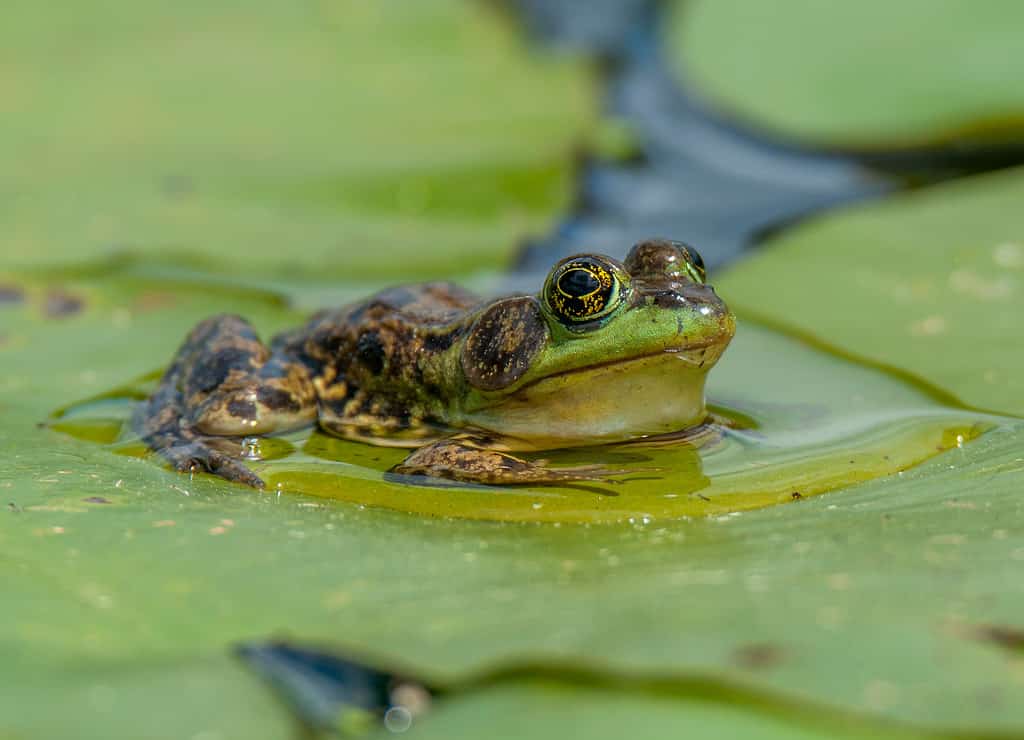
Mink frogs are found in a wide range of aquatic habitats, including lakes, ponds, and slow-moving streams, throughout much of Eastern and Central North America.
©Gerald A. DeBoer/Shutterstock.com
Conservation Status
Many species of the largest frogs found in the U.S. face conservation concerns due to habitat loss and degradation. These frogs require clean, stable freshwater habitats for breeding and development. Activities like agriculture, urbanization, and resource extraction have resulted in the destruction of their natural habitats. The use of pesticides and fertilizers in agricultural areas contaminates the water and harms these amphibians. In addition to habitat loss, these frogs face other threats, including climate change, disease, and predation by introduced species. To address these conservation concerns, efforts are being made to protect and restore freshwater habitats. Captive breeding and reintroduction programs are being implemented to help boost populations of some Lithobates species.
Summary of the 12 Largest Frogs Found in U.S. Rivers, Lakes, and Ponds
| Rank | Frog | Length |
|---|---|---|
| 1 | American Bullfrog | Up to 8 inches |
| 2 | Pig Frog | Up to 8 inches |
| 3 | Northern Red-legged Frog | Up to 5 inches |
| 4 | River Frog | Up to 5 inches |
| 5 | Rio Grande Leopard Frog | Up to 5 inches |
| 6 | Northern Leopard Frog | Up to 4 inches |
| 7 | Bronze Frog | Up to 4 inches |
| 8 | Green Frog | Up to 4 inches |
| 9 | Pickerel Frog | Up to 4 inches |
| 10 | Southern Leopard Frog | Up to 3.5 inches |
| 11 | Wood Frog | Up to 3 inches |
| 12 | Mink Frog | Up to 3 inches |
The photo featured at the top of this post is © iStock.com/ca2hill
Thank you for reading! Have some feedback for us? Contact the AZ Animals editorial team.






